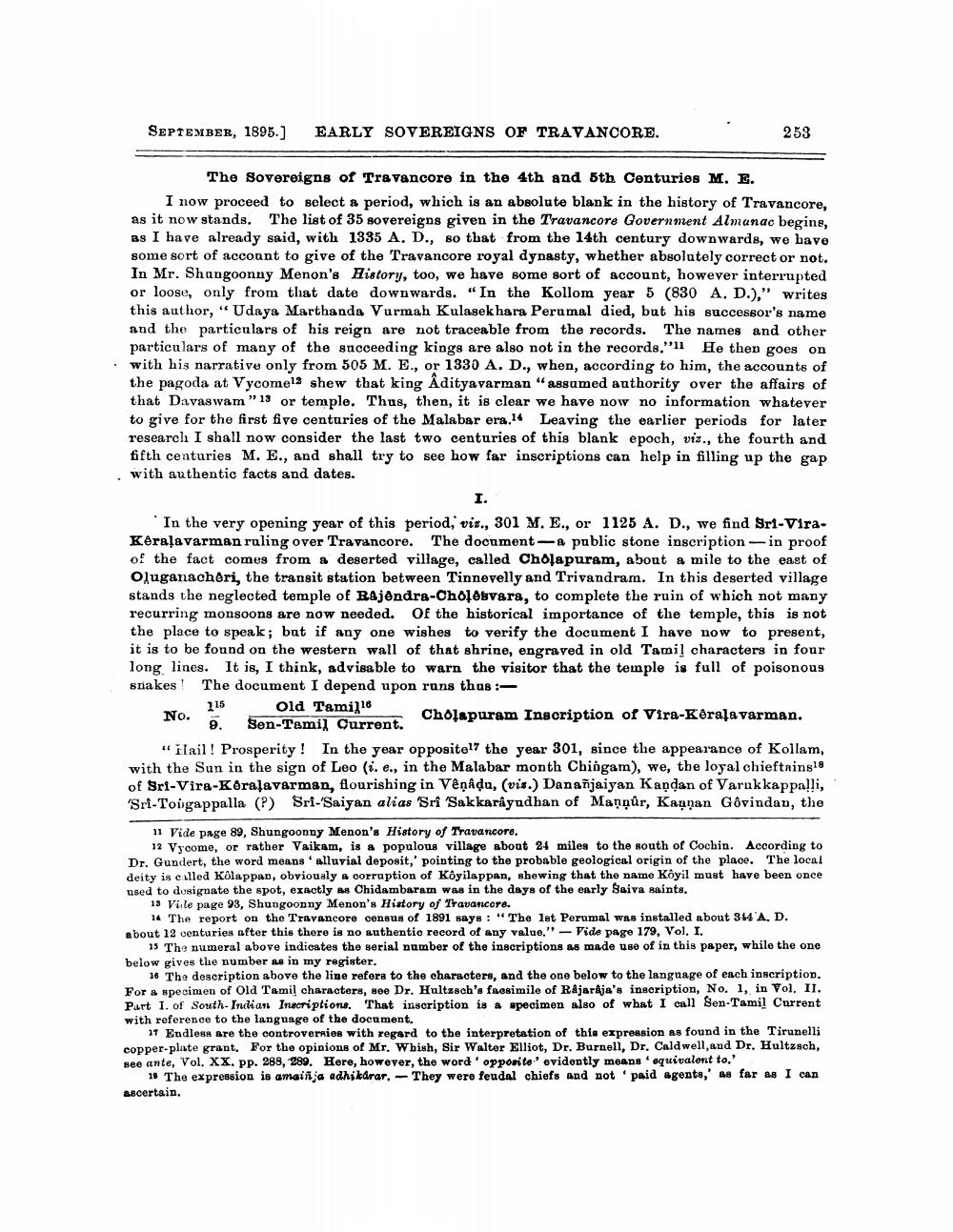________________
SEPTEMBER, 1895.]
EARLY SOVEREIGNS OF TRAVANCORE.
253
The Sovereigns of Travancore in the 4th and 6th centuries M. E. I now proceed to select a period, which is an absolute blank in the history of Travancore, as it now stands. The list of 35 sovereigns given in the Travancore Government Almanac begins, as I have already said, with 1335 A, D., so that from the 14th century downwards, we have some sort of account to give of the Travancore royal dynasty, whether absolutely correct or not. In Mr. Shungoonny Menon's History, too, we have some sort of account, however interrupted or loose, only from that date downwards. "In the Kollom year 5 (830 A.D.)," writes this author, "Udaya Marthanda Vurmah Kulasekhara Perumal died, but his successor's name and the particulars of his reign are not traceable from the records. The names and other particulars of many of the succeeding kings are also not in the records."11 He then goes on with his narrative only from 505 M. E., or 1330 A. D., when, according to him, the accounts of the pagoda at Vycomel shew that king Adityavarman "assumed authority over the affairs of that Davaswam " 13 or temple. Thus, then, it is clear we have now no information whatever to give for the first five centuries of the Malabar era 14 Leaving the earlier periods for later research I shall now consider the last two centuries of this blank epoch, viz., the fourth and fifth centuries M. E., and shall try to see how far inscriptions can help in filling up the gap with authentic facts and dates.
I.
In the very opening year of this period, vit., 301 M. E., or 1125 A. D., we find Sri-ViraKéraļavarman ruling over Travancore. The document-a public stone inscription - in proof of the fact comes from a deserted village, called Cholapuram, about a mile to the east of Oluganacheri, the transit station between Tinnevelly and Trivandram. In this deserted village stands the neglected temple of Rajendra-Cholesvara, to complete the ruin of which not many recurring monsoons are now needed. Of the historical importance of the temple, this is not the place to speak; bat if any one wishes to verify the document I have now to present, it is to be found on the western wall of that shrine, engraved in old Tamil characters in four long lines. It is, I think, advisable to warn the visitor that the temple is full of poisonous srakes! The document I depend upon runs thus :
115 Old Tami) 18 NO. . Sen-Tamil Current.
Cholapuram Inscription of Vira-Keralavarman. "ilail! Prosperity! In the year opposite17 the year 301, since the appearance of Kollam, with the Sun in the sign of Leo (i. e., in the Malabar month Chingam), we, the loyal chieftains18 of Sri-Vira-Koraļavarman, flourishing in Vêņådu, (vis.) Danañjaiyan Kandan of Varukkappalli, 'Sri-Tongappalla (?) Sri-'Saiyan alias Sri Sakkarayudhan of Manşûr, Kannan Gôvindan, the
11 Vide page 89, Shungoonny Menon's History of Travancore.
12 Vyoome, or rather Vaikam, is # populous village about 24 miles to the south of Cochin. According to Dr. Gundert, the word means alluvial deposit,' pointing to the probable geological origin of the place. The local deity is called Kõlappan, obviously corruption of Koyilappan, shewing that the name Köyil must have been once used to designate the spot, exactly as Chidambaram was in the days of the early saiva saints.
13 Viile page 93, Shungoonny Menon's History of Travancore.
14 The report on the Travancore census of 1891 says: “The let Perumal was installed about 344 A. D. about 12 centuries after this there is no authentio record of any value." - Vide page 179, Vol. I.
15 The numeral above indicates the serial number of the inscriptions as made use of in this paper, while the one below gives the number as in my register.
16 The description above the line refers to the characters, and the one below to the language of each inscription. For a specimen of Old Tamil characters, soe Dr. Hultzsch's facsimile of RAjardja's inscription, No. 1, in Vol. II. Part I. of South Indian Inscription. That inscription is a specimen also of what I call Sen-Tamil Current with reference to the language of the document.
11 Endless are the controversies with regard to the interpretation of this expression as found in the Tirunelli copper-plate grant. For the opinions of Mr. Whish, Sir Walter Elliot, Dr. Burnell, Dr. Caldwell, and Dr. Hultzsch, see ante, Vol. XX. pp. 288, 289. Here, however, the word ' opposita' evidently means equivalent to.'
18 The expression is amainja adhikarar. They were feudal chiefs and not paid agente,' As far as I can ascertain.




